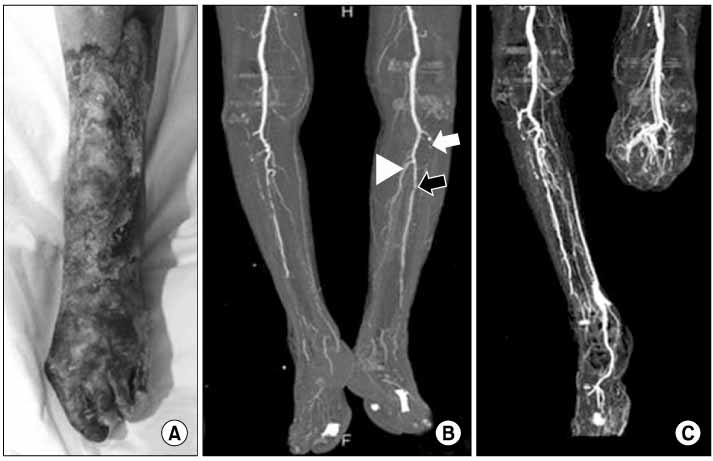J Korean Orthop Assoc.
2009 Oct;44(5):575-579. 10.4055/jkoa.2009.44.5.575.
Intraoperative Balloon Angioplasty in Diabetic Foot with Peripheral Artery Occlusive Disease During Amputation: Two Case Reports
- Affiliations
-
- 1Department of Orthopaedic Surgery, National Health Insurance Corporation Ilsan Hospital, Ilsan, Korea. hangugi@gmail.com
- KMID: 2186319
- DOI: http://doi.org/10.4055/jkoa.2009.44.5.575
Abstract
- Amputation should be considered for the patients with limb necrosis or infection due to major vessel obstruction combined with diabetes. Patients with peripheral artery occlusive disease combined with diabetes have a higher risk of amputation and a higher possibility of reoperation than those patients without diabetes because of complications that include hematoma, infection and necrosis of the stump. We report here on 2 cases for which balloon angioplasty was used to promote wound healing on the stump site during amputation, and the patients had peripheral artery occlusive disease with a diabetic foot. The wounds healed early without complication in both cases.
MeSH Terms
Figure
Reference
-
1. Hirsch AT, Haskal ZJ, Hertzer NR, et al. ACC/AHA 2005 guidelines for the management of patients with peripheral arterial disease (lower extremity, renal, mesenteric, and abdominal aortic): executive summary a collaborative report from the American Association for Vascular Surgery/Society for Vascular Surgery, Society for Cardiovascular Angiography and Interventions, Society for Vascular Medicine and Biology, Society of Interventional Radiology, and the ACC/AHA Task Force on Practice Guidelines (Writing Committee to Develop Guidelines for the Management of Patients With Peripheral Arterial Disease) endorsed by the American Association of Cardiovascular and Pulmonary Rehabilitation; National Heart, Lung, and Blood Institute; Society for Vascular Nursing; TransAtlantic Inter-Society Consensus; and Vascular Disease Foundation. J Am Coll Cardiol. 2006. 47:1239–1312.2. Ruef J, Hofmann M, Haase J. Endovascular interventions in iliac and infrainguinal occlusive artery disease. J Interv Cardiol. 2004. 17:427–435.
Article3. Karkos CD, Bright E, Bolia A, London NJM. Subintimal recanalization of the femoropopliteal segment to promote healing of an ulcerated below-knee amputation stump. J Endovascular Therap. 2006. 13:420–423.
Article4. Feiring AJ, Wesolowski AA. Antegrade popliteal artery approach for the treatment of critical limb ischemia in patients with occluded superficial femoral arteries. Catheter Cardiovasc Interv. 2007. 69:665–670.
Article5. Wolosker N, Nakano L, Duarte FH, De Lucia N, Leao PP. Peroneal artery approach for angioplasty of the superficial femoral artery: a case report. Vasc Endovascular Surg. 2003. 37:129–133.6. Lee SH, Choi DH, Ko YG, et al. Atherosclerotic obstruction of lower limb arteries in diabetic foot: effectiveness of percutaneous intervention. Korean Circ J. 2004. 34:151–158.
Article7. Villas PA, Cohen G, Goyal A, Putnam SG 3rd, Ball D. The merits percutaneous transluminal angioplasty of a superficial femoral artery stenosis via a retrograde popliteal artery approach. J Vasc Interv Radiol. 1999. 10:325–328.8. Yilmaz S, Sindel T, Ceken K, Alimoğlu E, Lüleci E. Subintimal recanalization of long superficial femoral artery occlusions through the retrograde popliteal approach. Cardiovasc Intervent Radiol. 2001. 24:154–160.
Article9. Choi JH, Ryu YS, Suh J, Seo HS, Cho YH, Lee NH. Successful recanalization of a long superficial femoral artery occlusion by retrograde subintimal angioplasty after a failed antegrade subintimal approach. Korean Circ J. 2008. 38:557–560.
Article
- Full Text Links
- Actions
-
Cited
- CITED
-
- Close
- Share
- Similar articles
-
- Managing Complicated Diabetic Foot Ulcers with Peripheral Arterial Disease
- Peripheral Transluminal Angioplasty for Limb Salvage in Critical Limb Ischemia in an Old Cerebral Infarction with Multiple Contractures
- Surgical Treatment of Diabetic Foot Disease
- Amputation in Diabetic Foot Ulcer and Infection
- Prevalence and Current Status of Treatment of Diabetic Foot in South Korea




